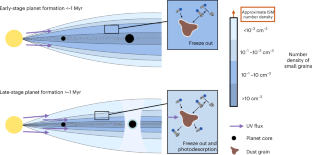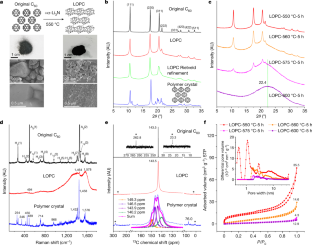2023-01-10 ミシガン大学
ミシガン大学天文学科の新しい研究により、惑星形成の後期段階における化学反応は、宇宙線やX線ではなく、紫外線によって促進されることが示唆されました。この新しい理解は、研究者が惑星形成円盤における宇宙の苗床まで外惑星を追跡するのに役立つ化学標識を提供するものです。
Nature Astronomyに掲載されたこの論文の筆頭著者である天文学の博士課程学生Jenny Calahanは、この発見は嬉しい偶然であり、これまでの研究を発展させたものであると述べています。
惑星形成円盤は、小石の多い塵の多い中間面、ガス大気、ガスと結合した小さな塵の集団という3つの主要な構成要素を持っています。惑星形成円盤が時間とともに進化するにつれて、環境の変化が内部の化学反応に影響を与える。そこでカラハンは、観測された明るさを説明するために、通常紫外線を遮断する小さな塵の質量を減らし、円盤の最も冷たい領域の奥深くまで紫外線が届くようにモデルを調整した。その結果、観測された明るさを再現することができた。
約20年前、研究者たちは、ガス状円盤の化学反応は、宇宙線やX線などのエネルギー源によって、より短い時間スケールで作用する化学反応に支配されていることに気づいたと、研究代表者であるエドウィン・バーギン教授兼天文学講座は述べている。「私たちの新しい研究は、本当に重要なのは、星が円盤から物質を吸収する際に発生する紫外線放射場であることを示唆しています」と、彼は言いました。「惑星を作る最初の段階、より大きな固体を形成することで、宇宙線やX線が駆動する初期段階から、巨大惑星が生まれると考えられている段階での紫外線が駆動する化学反応へとシフトするのです。
<関連情報>
- https://news.umich.edu/shift-to-ultraviolet-driven-chemistry-in-planet-forming-disks-marks-beginning-of-late-stage-planet-formation/
- https://www.nature.com/articles/s41550-022-01831-8
惑星形成後期の前兆としての紫外線駆動型化学反応 UV-driven chemistry as a signpost of late-stage planet formation
Jenny K. Calahan,Edwin A. Bergin,Arthur D. Bosman,Evan A. Rich,Sean M. Andrews,Jennifer B. Bergner,L. Ilsedore Cleeves,Viviana V. Guzmán,Jane Huang,John D. Ilee,Charles J. Law,Romane Le Gal,Karin I. Öberg,Richard Teague,Catherine Walsh,David J. Wilner & Ke Zhang
Nature Astronomy Published:08 December 2022
DOI:https://doi.org/10.1038/s41550-022-01831-8

Abstract
The chemical reservoir within protoplanetary disks has a direct impact on planetary compositions and the potential for life. A long-lived carbon- and nitrogen-rich chemistry at cold temperatures (≤ 50 K) is observed within cold and evolved planet-forming disks. This is evidenced by bright emission from small organic radicals in 1–10 Myr aged systems that would otherwise have frozen out onto grains within 1 Myr. We explain how the chemistry of a planet-forming disk evolves from a cosmic-ray/X-ray-dominated regime to a ultraviolet-dominated chemical equilibrium. This, in turn, will bring about a temporal transition in the chemical reservoir from which planets will accrete. This photochemical dominated gas phase chemistry develops as dust evolves via growth, settling and drift, and the small grain population is depleted from the disk atmosphere. A higher gas-to-dust mass ratio allows for deeper penetration of ultraviolet photons is coupled with a carbon-rich gas (C/O > 1) to form carbon-bearing radicals and ions. This further results in gas phase formation of organic molecules, which then would be accreted by any actively forming planets present in the evolved disk.



